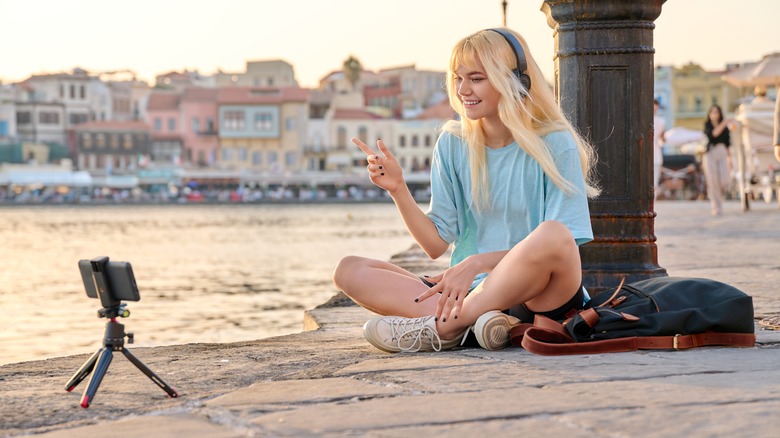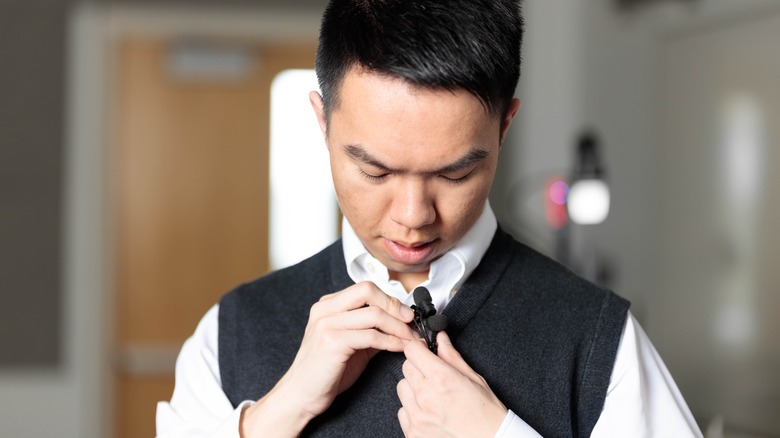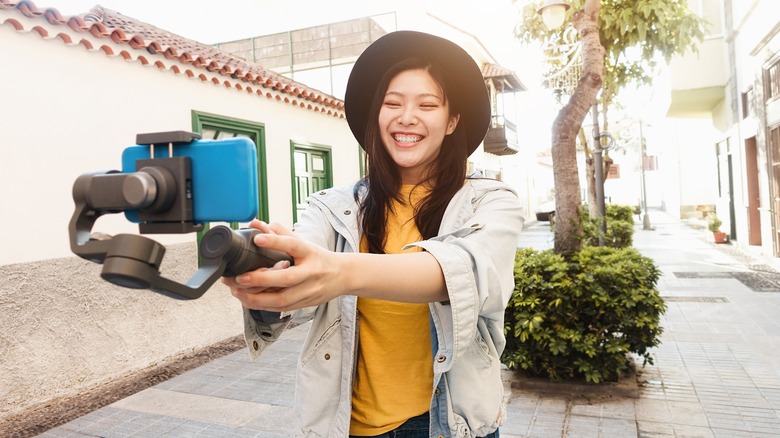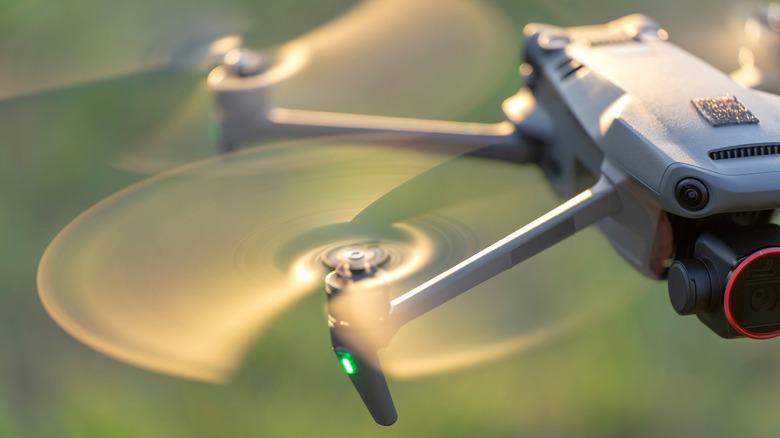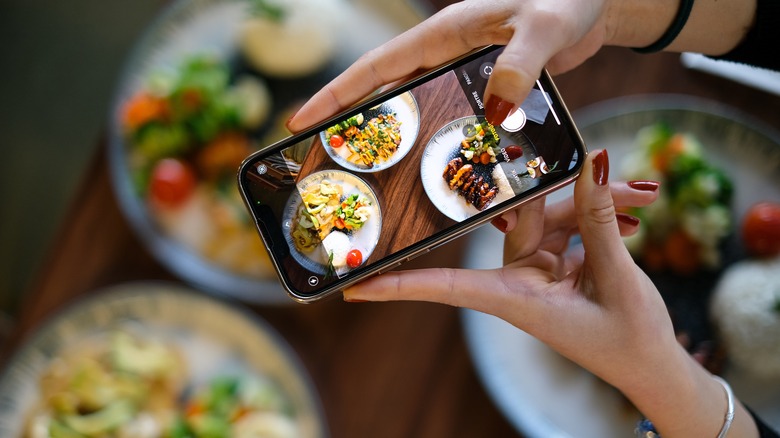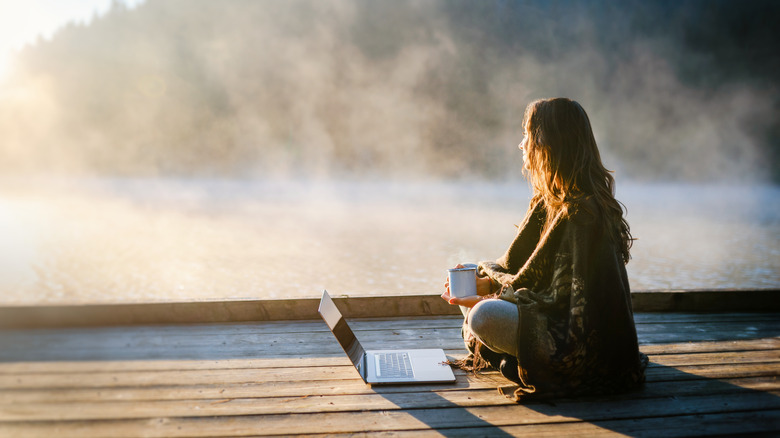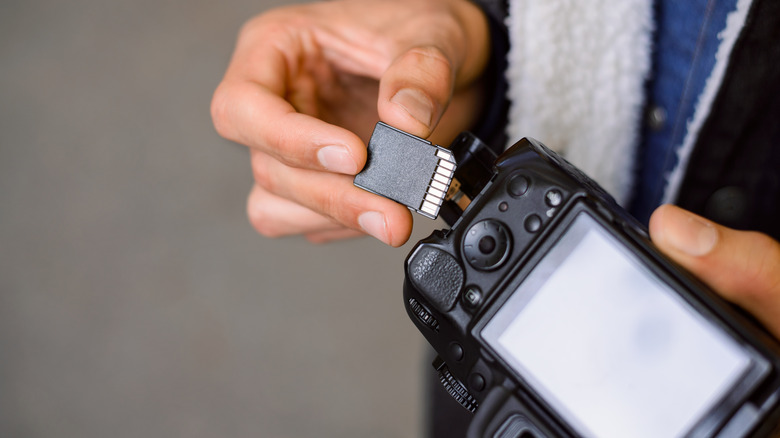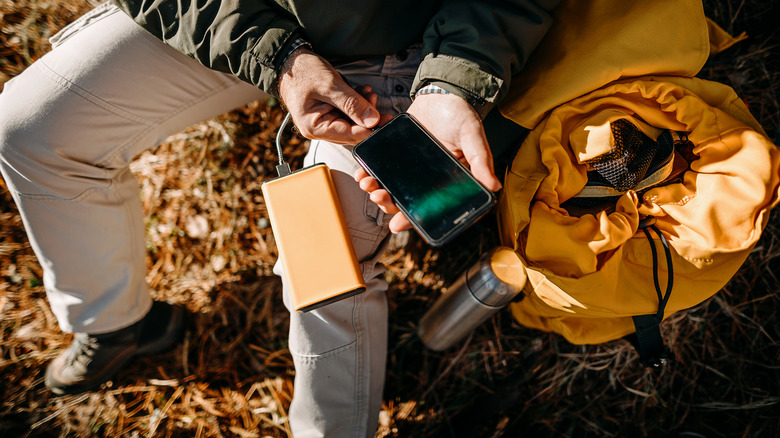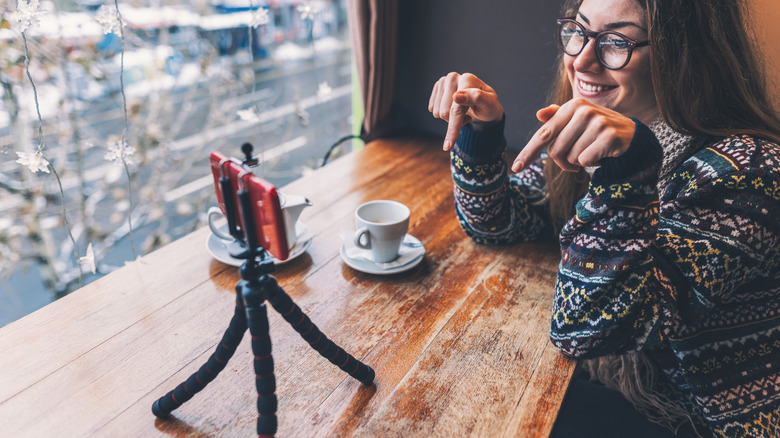10 Essential Tech Gear And Accessories For Travel Vloggers
We may receive a commission on purchases made from links.
With the travel industry continuing to thrive after the pandemic, millions of people are jet-setting around the world and recording their adventures on cameras and smartphones. Some long-term travelers have taken to the road to work remotely from these far-flung places. Others have taken it even further and started their own YouTube or TikTok travel channels, people who have come to be known as travel vloggers.
Travel vlogging is an art that admittedly takes some time and practice to master. On top of planning trips and adapting to different countries and cultures, travel vloggers must learn the basics of video production. They must also constantly develop content ideas and tell compelling travel stories through visuals and narration. Building an online presence is essential, too. If they want to be successful, they must promote their content across various platforms.
As a travel vlogger, you will need to lug around a bit more equipment than regular travelers. So, from cameras to suitable lighting, it's essential that all your equipment is as lightweight and compact as possible, without compromising on quality. If you're new to the travel vlogging game and are thinking about starting your own channel or blog, here are some of the best gear and accessories to consider.
Vlogging Camera
First and foremost, vloggers need a quality camera. While the Sony ZV-1 has been recognized as an excellent choice in almost all quarters, the Sony ZV-1 II has taken the art of vlogging to the next level. This is mainly down to the new 18-50 millimeter wide-angle lens that is essential for travel filming. If you're capturing landscapes high up in the Himalayas or shooting street scenes, you can create a much better sense of place and perspective with the more expansive views on offer.
We mentioned in our ZV-1 II review that Sony has finally delivered an ideal focal range for vlogging with the updated camera. We also noted that it retained its lightweight profile and reliable autofocus (which includes multi-face and animal recognition). The camera also boasts a built-in directional microphone, which is very capable. Plus, you get the option of adding an external shotgun microphone for even more pristine audio quality. Additionally, the camera's tilt-and-swivel touchscreen presents travel vloggers with almost unlimited framing options.
However, the ZV-1 II isn't going to be much use to any travel vloggers shooting serious action. If you're vlogging about your surfing, kayaking, cycling, or other action adventures, you'll need an action camera. For this, the GoPro Hero is the go-to choice. Not only were we impressed by the GoPro Hero 12's 5.3K resolution, but we also appreciated its high-quality slow-motion recordings and outstanding image stabilization. There's also an excellent Horizon Lock feature that contributes to more professional-looking videos.
Microphone
Those new to vlogging will probably be wondering which type of microphone is best. Two types of mic are generally considered to be the best for travel vlogging. One is the lavalier style, and the other is the shotgun microphone. A lavalier is the best choice for operating hands-free. The microphones clip onto clothing, and because you can place them close to your mouth, they offer consistent audio. They're also small and discreet, which means they will not be too noticeable in your footage.
Unfortunately, lavalier mics usually have a wired connection and can be prone to picking up ambient noise. However, newer models, such as the DJI Mic 2, have addressed this. We put the DJI Mic 2 to the test in early 2024 and were happy to report that the advertised 820-foot wireless range was indeed accurate, and that the active noise-cancelling was as effective as stated. We also delighted in the fact that the six-hour battery life of both the transmitter and receiver could effectively be tripled by the charging case.
But, if pristine audio is your top priority, a shotgun mic is still the way to go, especially when you shoot in noisy environments such as a busy market or a boisterous bar. One such mic suitable for travel vloggers is the Rode VideoMic Pro+. It's compact, lightweight, has an up to 100-hour battery life, and offers premium audio. While a shotgun mic does need mounting on your camera's hot shoe, and they don't have the discretion that lavalier mics do, it's the best choice for a more focused and polished sound.
Portable Light
Because travel vloggers are constantly on the go, cumbersome and bulky equipment is something to try and avoid. When it comes to lighting, you need something that packs a punch while still being easily portable. The Lume Cube 2.0 checks all those boxes with its small, pocketable size and powerful luminosity. It's even waterproof up to 30 feet, meaning you can light up colorful underwater worlds while snorkeling or shallow diving. It offers an impressive 1,500 lumens (750 lux at one meter), a 5,600K daylight color temperature, and a CRI of 95 that ensures natural color rendering.
But, for a wider and softer light, a slim, lightweight LED panel is the better choice. The Aputure AL-M9 is an ultra-slim, credit card-sized panel with nine levels of brightness. Light output is strong at up to 900 lux at 0.3 meters, and color rendering is high with both CRI and TCLI over 95, crucial for natural-looking hues in your videos.
The light also sports a 120-degree wide-beam angle, allowing travel vloggers to illuminate more expansive shots in a variety of settings. Additionally, magnetic diffusion filters enable vloggers to modify the light quality and reduce harsh shadows. The light's built-in battery allows for cordless operation, and it has a life of one hour and 45 minutes at its brightest setting.
Gimbal
Shaky, jittery videos are tough to watch. Therefore, stabilizing gimbals are essential for travel vloggers who want to ensure high-quality video output. Whether you're hiking up steep steps to a mountaintop temple, riding in the back of a tuk-tuk in Thailand, or simply walking and talking on the streets, it's essential to keep that footage steady.
The DJI RS 3 Mini may lack some of the features and accessory support its bigger siblings (like the traditional DJI RS 3) can boast — however, as the name suggests, it's a much more portable option for far-flung travel-vlogging destinations. It's also an easy gimbal to set up and use. Its intuitive controls allow for quick adjustments and make it easier to capture spontaneous travel moments. And its 4.4-pound payload capacity means it can support even the heaviest full-frame camera. It also has a long all-day battery life and a relatively quick charge time.
The DJI RS 3 Mini, however, is designed for cameras. If you're a travel vlogger who shoots with a smartphone, you need a smartphone gimbal. Our reviewer was impressed with the Insta360 Flow, a streamlined smartphone gimbal that's ideal for smartphone vlogging. The stabilization performance and subject tracking left particularly good impressions, while the built-in cold mount shoe, which you can use to attach a lavalier mic receiver, was the cherry on top.
Drone
A drone is the only real way for travel vloggers to get professional-grade aerial shots of buildings, nature, festivals, or any other events that require a shot from the sky. While there are some excellent compact drones with seriously good specs for vloggers — which you can fold down and stow away in your carry-on luggage or even a pocket — travelers need to pay close attention to the weight of the drone. This is not just to keep the weight of your luggage at a minimum, but also because drones need to be registered in most countries if they're over 250 grams (or 8.8 ounces).
Many drones under this weight are of questionable quality and, once the wind picks up, challenging to fly. But there are some top-tier mini drones, such as the DJI Mini 4 Pro, that offer some excellent photography and video specs as well as good wind resistance. This drone also features impressive object tracking, and the omnidirectional object avoidance is a good addition for newbie pilots.
The DJI Mini 4 Pro is a class leader in video quality for a drone of its size, with a 4K/60FPS HDR output for traditional filming and 4K/100FPS for some seriously detailed slow-motion. However, our reviewer believed it to be only an "evolutionary upgrade" on the DJI Mini 3 Pro, so if you want to save some money while still getting high quality, that could be the way to go.
Smartphone
A good smartphone is essential for the travel vlogger. High-end models offer quality camera and video features on top of quick access to social media platforms, and are often fast enough to use editing apps. Smartphones also provide travel essentials such as map navigation, translation tools, and booking platforms. You could say a quality smartphone is something of a hub for the travel vlogger.
If you have the pockets for it, the Samsung Galaxy S24 Ultra is easily the top dog among Android phones. It not only delivers high-quality stills with its standout camera, but you also get 8K video. For slow motion, you have 4K at 120FPS or Full HD at 240FPS. It's also a highly durable device, although the S24 Ultra's AI features are a bit of a mixed bag.
Apple lovers should look to the iPhone 15 Pro, or if you're going all out, the iPhone 15 Pro Max. It doesn't quite boast the frame rates that the S24 Ultra does, but video and camera performance are still top-notch. You also get ProRes video recording for higher quality and more editing flexibility. In our iPhone 15 Pro review, we noted that the video stabilization was also very impressive.
If you're on a budget, though, you don't need to splash out quite so much cash for premium video specs. The OnePlus 12, for example, also offers 8K video. And if you don't mind your slow motion in Full HD rather than 4K, it's a good shout. We liked the OnePlus 12's overall camera and video performance and were also pleased with its battery, speed, and storage.
Laptop
While travel vloggers can get away with just using a good smartphone, especially when starting out, you'll need a good laptop as your needs become more advanced. Editing will likely get more complicated, you'll start working with larger files, and you'll begin multitasking with CPU-intensive apps.
If you're looking for a powerful, lightweight computer, MacBooks are top-rated machines for video editing. For the latest and greatest, the MacBook Pro M3 Max offers more power than you will likely need. The MacBook Pro M3 Pro is also a beast, but comes at a lower price point. You can choose between the 14- and 16-inch models for both, with the former obviously the more compact option for travel vloggers. The MacBook Air 13-inch with the regular M3 chip is even more compact and still offers standout power. You can even opt for the older M2 chip, which still boasts enough performance for most vloggers and will save you a bit of cash.
For a Windows alternative, the Asus ProArt Studiobook 16 OLED is a top choice. It's specifically designed for video editing and features a stunning OLED display. And, with a variety of configurations to choose from, you can simply select the power you need and pay the price that reflects it. In terms of good editing software, Adobe Premiere Pro is the go-to choice for many, whether you're a Mac or a Windows user. However, there are other good options, such as CyberLink PowerDirector 365 and, exclusive to Mac users, Apple Final Cut Pro.
Storage Card
Video file sizes can add up over the course of a day's shooting, especially if you record in higher resolutions. For a full day of 4K shooting, you'll need a storage card with a minimum of 64GB. If you don't offload for multiple days, then you'll need a minimum of 128GB, higher for longer trips if you have no access to your computer.
If you're the type of travel vlogger who is partial to capturing the action — whether shooting sports events and wildlife or parades and festivals — you'll need a card with fast write speeds. These cards can keep up with your camera's burst mode and record smooth video without dropping frames. They can also clear your camera's internal buffer more quickly for even more seamless recording.
The Lexar Professional 2000x SDXC UHS-II is one such card. It achieves lightning-fast write speeds of up to 260MB/s and read speeds of up to 300MB/s. Transferring files to an external drive or laptop is also a more speedy process, and the card has a storage capacity of up to 256GB. Its V90 video speed class meets the requirements for 4K and 8K recording, and it can even withstand the shocks, vibrations, and temperature extremes you may encounter while traveling.
Portable Charger
Travel vloggers out on a shoot can keep their smartphone, camera, drone, or other necessary equipment powered up with a portable charger. The Anker PowerCore+ 26800mAh PD even features a 45W USB-C port that will keep a laptop juiced up.
In addition to the PD port, this charger has two 15W USB-A ports, and you can charge devices simultaneously, ensuring you can keep capturing and editing content throughout the day. In addition, the 60W wall charger ensures the battery is at 100% after about three and a half hours.
It sports a highly durable aluminum alloy body that can easily withstand the rigors of travel and any outdoor events you film. However, despite its high capacity, the PowerCore+ is still slim and light. It will slip unnoticeably into your dayback or camera bag, and, as the capacity is under 27,000mAh, you can take it on flights without worry of FAA scrutiny.
Portable Tripod
Finally, a portable tripod can come in handy for hands-free recording, especially for interviews or talking head videos. You can also create nice cinematic effects with some smooth panning and tilting, while tripods are indispensable for shooting in challenging light or when recording timelapses.
The Peak Design Travel Tripod offers some serious portability and stability. It folds down to just 38.5 cm, yet can reach the dizzy heights of 153 cm. The integrated ball head supports a payload of up to 20 pounds, the setup is easy and swift, the build quality is good, and it also features a smartphone clamp if you need it.
Another option is the Joby GorillaPod 3K Kit. It's even smaller and more portable, but it offers a different type of stabilization. It has flexible spine-like legs that you can use to find unique angles or even wrap around poles or branches. It may not provide the stability that traditional tripods do when the wind picks up, but it is stable enough in most situations. It's also one of the best tripods for smartphones.
The Joby GorillaPod comes with a ball head mount with 360-degree panning and 90-degree tilting and supports up to 6.6 pounds. There are also 1K and 5K options, with the former available with a smartphone mount and the latter designed for heavier payloads. You can also add extra "arms" to these tripods and attach accessories such as an LED light or a microphone.
